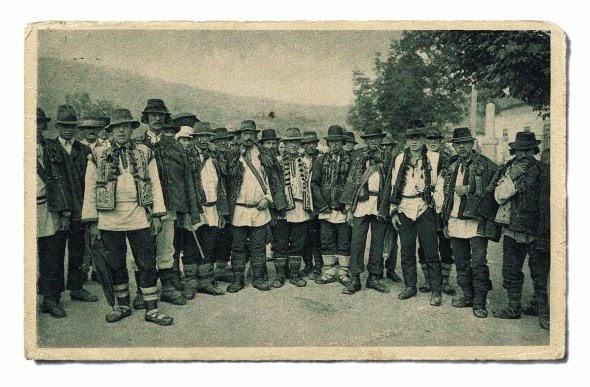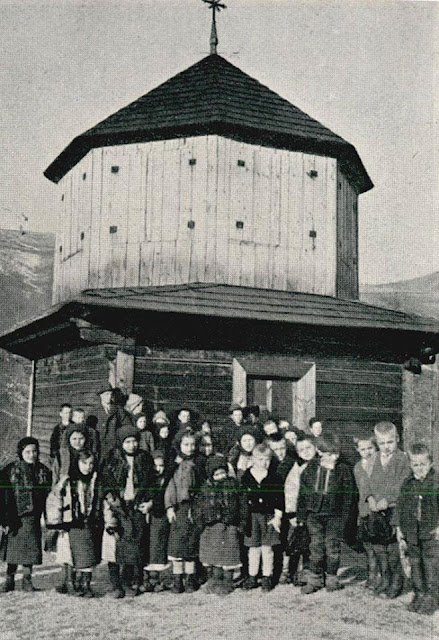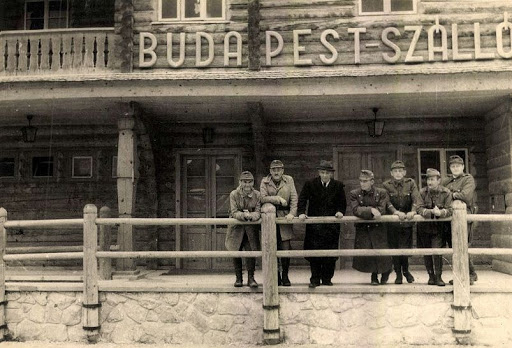A Brief History of Yasinya
Yasinyanska Territorial Community is located in the Rakhiv district of the Zakarpattya region in Ukraine. Its area is about 534 sq km and its population is about 18,500 people. The community includes Stebnyy, Kvasy, Sitnyy, Trostyanets, Lazeshchyna, Chorna Tysa villages, and the small town of Yasinya, which is the center of the community.
Yasinya: from the past to the present. Photo by Vasil Bakkai
Yasinya has a unique history, as it bears an imprint of multiple epochs. Here one can find the authentic Hutsul tradition combined with German, Hungarian, Romanian, Czech, and Soviet influences. The Hutsul Republic was established here, the Carpathian Sich formed, and the defensive line of the Second World War was crossing nearby. Local people have preserved customs and rites, they conserved a special Hutsul dialect. In these mountains and valleys sheep farming had been developed, traditional crafts nurtured, and a center of tourism, known throughout the USSR, created.
The first mention of the settlement dates back to 1555. According to legend, a Galician shepherd Ivan Struk named this area in honor of the ash tree, from which he made a sheepfold here, moving to these places with the whole family later on. Documentarily, Yasinya belonged to Hungarian feudal lords, often opposed by local Opryshok rebels.
Habsburg Period - Kingdom of Hungary (before 1867)
XVIII-XIX centuries was a period of German colonization, urbanization, development of schools that taught in Church Slavonic and Hungarian languages. Surrounded by virgin forests, Yasinya and its neighborhoods obtained specialization in forestry: felling of trees, river rafting, making wooden carts, sleds and barrels. Since 1800, a Jewish community has settled in the village.
Unique wooden churches remained on the territory of Yasinya Community from that time. Most of them were built in the XIX century, including the Strukivska Church in Yasinya, which is under the auspices of UNESCO.
Austro-Hungarian period (1867-1918)
A decrease in birth rates and mass resettlement to the United States was a significant trend of that time. The village had the Hungarian name - Körösmező-Felső, but the population was mostly Hutsuls (Ukrainians) and Greek Catholics (68.7%) according to religious beliefs. Although a significant proportion were Roman Catholics (12.2%), Jews (18%), and Protestants (1%).
During this period, people built new temples were and arrange cemeteries. The first burials also appear in the Jewish cemetery, preserved on a hill in the central part of the village.
Oil development started in the vicinity of Yasinya. The first drilling rings were built, yet the production was unprofitable. The majority of the population worked in agriculture and forestry.
At the end of the XIX century, a railway passed through Yasinya, connecting the center of the county of Sighetu Marmatiei in Transylvania with the cities of Galicia, and in 1895 a luxurious railway station was opened (later destroyed during the Second World War). One can still see the remains of large-scale constructions with railway bridges, tunnels, and aqueducts on the territory of the modern Yasinya Community.
Hutsul Republic (1918-1919) and Romania (1919)
The national liberation struggle swept across Europe during 1917-1921. Military uprisings also took place in Zakarpattya, therefore in November 1918, the Hutsul Republic was proclaimed with the center in Yasinya. After seven months of existence, lacking external support, the capital of the republic was captured by the Romanian army.
The Czechoslovak period (1919-1938)

As a result of great European politics, Yasinya became an autonomous unit of the Czechoslovak state. The new authorities implemented administrative reforms, established a military garrison, repaired roads, and expanded railway connections. The Czechoslovak government invested in the development of oil fields in Stebnyy, sent Zakarpatian artisans on internships to Moravia and Bohemia, supported hospitals, and encouraged small businesses (restaurants, confectionery, photo studio, etc).
In 1921, several institutions were established in Yasinya: a professional carving school, a local football team, a branch of Prosvita, a volunteer fire brigade, steam sawmills, construction companies, Hutsul Cooperative Union, and Samopomich credit cooperative. The small town and its environs were developing rapidly, the population was growing.
Czechoslovakia also made an input in the region’s development as a tourist brand, promoting landscapes, ethnographic exotics, and visits to military cemeteries. Tourists were invited to ride on the narrow-gauge railway "Yasinya - Kozmeshchyk", visit the shepherds' huts, and try Emmental dairy products in the cheese factory near Kvasy. Since that time, several buildings have survived in Yasinya (contemporary house of rescuers, a fire station, and forestry).
The Carpathian Ukraine (1938-1939) and the Kingdom of Hungary (1939 - 1944)
With the disintegration of Czechoslovakia, Hungarian troops took over the territory. People were not satisfied with the occupation, and many rebels from Yasinya took part in the struggle for independence as part of the Carpathian Sich, an armed formation of the newly created state of the Carpathian Ukraine with the center in Uzhgorod. It lasted only a few months, thus Zakarpattya became a part of the Kingdom of Hungary in March 1939.
In World War II, Hungary sided with Nazi Germany, and Yasinya appeared on the borderline with the Soviet Union. The military actions destroyed the railway station, numerous bridges, and houses. In Yasinya repressions intensified, and residents were mobilized to the frontline. Local Jews were taken to concentration camps, from which most of them never returned.
 Jews are put in a deportation truck
Jews are put in a deportation truck
Hungarian army in Transcarpathia. 1939. Photo by Berko Pal
In 1940, construction of the large fortification complex - the Arpad Line - started nearby Yasinya. At the same time, the Budapest Hotel was built to host Hungarian officers and engineers. The building has survived till modern days under the name Edelweiss.
Modern Times (since 1991)
In the 1990s the flow of tourists decreased because no one was able to issue budget vouchers anymore. Mostly amateur and green tourism remained. After the campsites became private property and the paying capacity of the people improved, tourism in the area intensified again. Yasinya has a private cable road and trails for beginners, it is easy to get to the popular ski resorts from here. So in winter tourists arrive here for skiing, and in summer they enjoy hikes to the mountain peaks: Hoverla, Petros, Blyznytsya, and Drahobrat. Also, with the development of tourism in the Yasinya Community, many annual festivals were launched to promote folk crafts, Hutsul humor, caroling customs, local folklore, and dishes. In 2020, Budapest Hotel Art Residency was held for the first time in Yasinya involving Ukrainian artists. In 2021, a second residency will take place, attended by artists from 5 countries. The project invites residents to study the unique history of Yasinya and its surroundings, reinterpret it through art and create a new, broader vision of tourism in the region.



















Comments
Post a Comment